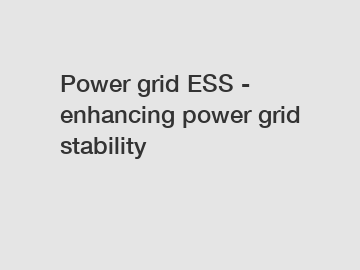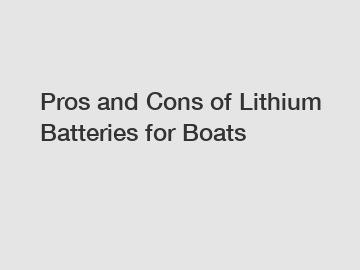LiFePO4 VS NCM: Which Battery Is Better
Aug. 06, 2024
LiFePO4 VS NCM: Which Battery Is Better
LiFePO4 VS NCM: Which Battery Is Better
If you want to learn more, please visit our website Lithium Storage.
1. What Are the Primary Constituents of Lithium Batteries?
Lithium batteries are composed of four essential components: the cathode material, anode material, electrolyte, and separator. Each of these elements plays a crucial role in the battery's performance and efficiency.
' Electrolyte
The electrolyte serves as a conduit for the transfer of lithium ions between the positive and negative electrodes. It is typically composed of organic solvents and lithium salts.
One commonly used lithium salt is lithium hexafluorophosphate, which is essential for facilitating ion transfer within the battery.
' Separator
Positioned between the positive and negative electrodes, the separator's primary function is to prevent internal short circuits.
Additionally, it enables the passage of lithium ions while creating a conductive pathway, essential for the battery's operation.
' Cathode Materials
Cathode materials come in various types, including ternary materials'NCM,NCA', lithium iron phosphate, lithium manganese oxide, and lithium cobalt oxide.
These materials define the battery's characteristics and performance, making them a critical factor in battery technology.
Understanding the components of lithium batteries, including their electrolytes, separators, and cathode materials, is crucial for developing more efficient and sustainable lithium-ion battery solutions. This knowledge is essential in the pursuit of cleaner and more advanced energy technologies.
Lithium carbonate plays a pivotal role as a primary source of lithium for the production of various cathode materials. When combined with other compounds, it serves as the foundation for synthesizing critical materials such as lithium iron phosphate (LiFePO4), ternary nickel cobalt manganese (NCM), lithium manganese oxide, and lithium cobalt oxide. Among these, LiFePO4 and NCM materials stand out as the most widely utilized cathode materials in battery technology.
2. What Are the Roles of Different Elements in NCM/NCA Lithium Materials?
Ternary elements, commonly recognized as nickel, cobalt, and manganese (NCM), as well as nickel, cobalt, and aluminum (NCA). The numbers following NCM denote the relative proportions of these three elements, as illustrated in the figure below.
Each of these elements has distinct responsibilities within the positive electrode material, contributing to the overall performance of the battery:
' Nickel (Ni)
Nickel is primarily employed to boost energy density, resulting in increased battery capacity.
This enhancement in energy density enables batteries to store and deliver more power, making them ideal for high-performance applications.
' Cobalt (Co)
Cobalt plays a crucial role in stabilizing the layered structure of the positive electrode material.
This structural stability enhances material magnification and cycling performance, contributing to longer-lasting and more reliable batteries.
' Manganese (Mn) or Aluminum (Al)
Manganese or aluminum is incorporated into the mix to enhance battery stability and safety.
These elements contribute to the overall durability and reliability of batteries, ensuring they perform consistently over their lifespan.
3. Which Battery Technology Will Lead the Market: NCM or LiFePO4?
Let's review them in three aspects.
' Cost
The raw material cost of lithium iron phosphate mainly includes lithium, phosphorus, and iron
1T LiFePO4 cathode material=0.25T Lithium Carbonate +0.87T Iron phosphate
1GWh LiFePo4 battery request - tons of Lithium Iron phosphate
The NCM cathode materials generally uses nickel cobalt ore, manganese oxide, and lithium hydroxide (the main synthetic material is lithium carbonate), while lithium hydroxide is commonly used (taking 532 as an example)
1T NCM cathode material= 0.38T Lithium Carbonate/0.45T Lithium hydroxide+0.096 Nickel +0.048 Tcobalt+0.032Tmanganese
1 GWh NCM battery requires tons of NCM cathode materials
In today's market, NCM (Nickel-Cobalt-Manganese) lithium batteries demand a higher lithium input compared to LiFePO4 (Lithium Iron Phosphate) batteries. Approximately 681 tons of lithium carbonate are required to produce 1 GWh of NCM lithium batteries, while 1 GWh of LiFePO4 batteries necessitates around 645 tons of lithium carbonate (taking the intermediate value).
NCM lithium batteries rely on two precious metals, nickel and cobalt, both of which tend to be relatively costly. Cobalt, in particular, presents a unique challenge due to its limited availability. Roughly 66% of the world's cobalt supply originates from the Democratic Republic of Congo in Africa, leading to price volatility.
When assessing the cost breakdown, it's important to note that the cathode material of an NCM battery constitutes approximately 60% of the total battery cost, while lithium iron phosphate accounts for roughly 30%.
' Safety
NCM Material Safety:
NCM materials start to decompose at temperatures exceeding 200 degrees Celsius. This decomposition results in the release of a significant number of oxygen atoms, triggering intense chemical reactions with the battery's solvent. This process generates a substantial amount of gas and heat. If this gas and heat cannot be dissipated promptly, it may lead to deflagration or rapid combustion.
Can NiCd batteries be recharged?
How Camel Power M Sdn Bhd Innovates Renewable Energy Solutions
Key Questions to Ask When Choosing PT Camel Power Indonesia
How Does Camel Group Co. Ltd's Battery Compare?
Microinverters vs String Inverters: Pros & Cons Guide
Lighting the Way: A Guide to Exit Signs & Emergency ...
If you want to learn more, please visit our website Ncm Baterie.
Recommended article:2V 50Ah
LiFePO4 Material Safety:
In contrast, LiFePO4 exhibits remarkable stability, with an upper temperature limit of around 700 degrees Celsius. Its olivine microstructure contributes to this stability, making it highly resistant to thermal runaway and decomposition.
However, it's essential to approach safety dialectically, considering not only the properties of the battery cells but also the design of the entire battery pack (PACK). Under normal operating conditions, a power battery's working environment rarely exceeds 60 degrees Celsius. Even during extreme weather conditions, a robust thermal management system ensures that the PACK remains within safe temperature ranges. In the unlikely event of a thermal management system failure, safety measures, including circuit breakers, are in place to prevent temperatures from reaching critical levels.
It's crucial to recognize that safety is a multifaceted and systematic concept, and it cannot be solely defined by the positive electrode materials. Instead, a comprehensive approach to battery design, monitoring, and control is necessary to ensure the highest level of safety.
' Performance
The performance of the battery is the ultimate determinant of its trajectory.
Why does lithium iron phosphate (LiFePO4) have good cycling performance?
Olivine Structure Stability:
LiFePO4's positive electrode boasts an olivine crystal structure, renowned for its remarkable stability. This stability ensures a secure molecular framework that remains intact throughout the battery's lifecycle. As a result, it maintains a one-dimensional channel for ion movement, effectively limiting their diffusion and migration efficiency.
Enhanced Cycling Longevity:
The restricted ion migration allows for rapid ion movement along a single plane, albeit with limited electron conductivity due to the closely packed lattice structure. However, this inherent stability and consistent molecular arrangement contribute to LiFePO4's impressive cycling life, which can extend up to an astonishing - cycles.
Because of this, the low-temperature performance of iron phosphate is poor. Originally, the migration of lithium ions is slow, and the impedance increases at low temperatures. The viscosity of the electrolyte further hinders the performance. Therefore, the capacity retention rate of iron phosphate at -20 degrees Celsius is only about 60%, while the ternary structure can achieve more than 70%. But objectively speaking, the difference between the two at room temperature is not significant.
4. Why does NCM lithium have high energy density?
' Lattice Structure:
Examining the lattice structure, lithium predominantly occupies 3A positions within the lattice. Simultaneously, nickel, cobalt, and manganese are scattered in a disordered fashion at 3B positions, with oxygen filling 6C positions. This arrangement creates the MO6 octahedral structure, with 'M' representing the transition metal. Consequently, the ternary positive electrode consists of lithium ions and transition metal oxides.
' Interlayer Advantage:
The lattice can be visualized as a layered assembly of MO6 octahedral and Li06 octahedral layers. This arrangement is exceptionally conducive to the insertion and extraction of lithium ions. In essence, the interlayer structure of ternary materials is more open, facilitating the seamless movement of lithium ions between the MO6 layers.
Additionally, when it comes to coating positive electrode materials, NCM materials boast a higher compaction density (up to 3.5g/cm3) compared to iron phosphate (2.3 to 2.4g/cm3). This difference further elevates the energy density of NCM materials.
5. NCM vs. LiFePO4 ' Which Battery Technology Will Prevail?
From the current technology and market situation, the market share of iron phosphate will be very high for a long period of time.
Firstly, the cost of iron phosphate is relatively small, does not involve precious metals, is rich in minerals, and has a simple industrial structure.
Secondly, iron phosphate can improve the migration efficiency of electrons and ions to a certain extent without sacrificing stability through methods such as carbon coated nanoparticle doping process.
Thirdly, advancements in battery pack design, such as the implementation of CTP (Cell-to-Pack) structures, have the potential to substantially boost the overall energy performance of LiFePO4 batteries at the PACK level.
These factors collectively suggest that LiFePO4 technology is well-positioned to continue its dominance in the battery market. If you're seeking further insights or guidance on choosing the optimal battery technology for your specific requirements, please don't hesitate to reach out to Bonnen team. We're here to help you make informed decisions and elevate your lithium battery solutions.
Comparing NMC and LFP Lithium-Ion Batteries for C&I ...
Comparing NMC and LFP Lithium-Ion Batteries for C&I Applications
The emerging energy storage industry can be overwhelming, but it is also exciting, with significant opportunities for impact. Energy storage is increasingly adopted to optimize energy usage, reduce costs, and lower carbon footprint. Among the various lithium-ion battery chemistries available, Nickel Manganese Cobalt (NMC) and Lithium Iron Phosphate (LiFePO4, or LFP for short) have emerged as popular choices for large-scale stationary energy storage applications. The strengths and drawbacks of each battery chemistry are important to align your product selection with the performance requirements of your overall system.
Understanding Battery Chemistry
In a previous article, we discussed how a lithium-ion battery works and provided an introduction to NMC and LFP batteries. Let's dive into the details further.
NMC Battery Composition
NMC batteries are a type of lithium-ion battery with a cathode composed of nickel, manganese, and cobalt. Nickel is the primary source of energy storage with high specific energy, but it needs manganese and cobalt to stabilize and provide the desired power output. These batteries are comprised of a ratio of material of 8:1:1 (8 parts nickel, 1 part manganese, 1 part cobalt) to minimize the use of Cobalt, which is expensive and difficult to procure. NMC batteries are all around us and are most commonly used in smartphones, laptops, and electric vehicles.
LFP Battery Composition
LFP batteries are another variant of lithium-ion batteries that employ roughly equal amounts of iron and phosphate within the cathode. The materials that makeup LFP batteries are more abundant, cheaper, and less toxic (so easier to recycle) than those in NMC. LFP batteries are commonly used in stationary energy storage and are under consideration for other markets as well, such as electric vehicles.
Material composition of typical LFP (left) and NMC (right) battery cells.Comparing NMC vs. LFP
Now that we have outlined the basics of each battery chemistry, let's compare their performance and use case for stationary energy storage systems in the commercial and industrial (C&I) sectors.
Energy Density
The energy density and size of individual cells and integrated packs are important considerations that drive the cost of equipment. Larger packs need more material to contain them, and in project development, more space increases land costs. The specific energy of LFP, ranging from 90 to 120 Wh/kg, is less than that of NMC (150 to 220 Wh/kg).
However, that is not the full story. While the individual NMC cells have higher energy density, the higher safety of LFP means the cells can be packed more tightly together. Therefore the total size of an integrated pack is not as different as the cell density may suggest, as represented in the chart below.
Representative component volumes for an NMC and LFP integrated pack.Safety
Safety is of paramount importance for energy storage systems. LFP batteries excel in this area, offering a higher level of safety and thermal stability than NMC batteries. The inherently stable chemistry of the iron phosphate cathode structure provides LFP batteries with enhanced resistance to thermal runaway, overheating, and fires, which are critical safety concerns in C&I applications. LFP batteries' higher safety and ability to handle more stress and abuse are primary benefits of the technology.
Performance
Overall, performance is comparable between NMC and LFP batteries for energy storage applications. NMC batteries tend to have slightly higher power densities, allowing them to discharge and charge at higher rates compared to LFP batteries. While this is valuable for certain applications, the specific power capabilities of LFP are sufficient for stationary energy storage applications.
Cycle Life
LFP batteries present a compelling advantage for stationary energy storage systems for C&I systems where long-term reliability and durability are paramount. NMC batteries can achieve ' charge-discharge cycles, while LFP batteries typically deliver 3,000 cycles or more. The higher cycle life means that LFP batteries will last longer, leading to reduced operational costs over the battery's lifespan.
Cost
Cost considerations play a crucial role in evaluating the feasibility of energy storage projects. As discussed in our recent post on the Inflation Reduction Act, project selection and execution are largely driven by the expected return on investment on project costs. Currently, due to their extensive use in electric vehicles, NMC batteries have a stronger supply chain and lower capital cost than LFP batteries. This discrepancy is anticipated to come down with continued growth in the LFP demand. It is also important to not only consider the upfront investment but also the levelized cost of electricity (LCOE) over the battery system's lifetime. With significantly longer cycle life, LFP batteries have better long-term financial viability, as suggested by the PNNL table below. A further breakdown of project costs using LFP batteries is available from NREL.
Conclusion
Nickel Manganese Cobalt (NMC) and Lithium Iron Phosphate (LFP) both fall under the 'lithium-ion' battery category, but differ based on a number of important factors. While NMC batteries boast higher energy density and specific power'making them suitable for space-constrained applications with high power demands'LFP batteries excel in safety, thermal stability, and cycle life, making them ideal for stationary energy storage projects where safety and long-term reliability are paramount.
For most C&I facilities seeking to implement stationary energy storage systems, the LFP advantages make it the most likely the best choice for your project. This is reflected in the increased use of LFP in many battery manufacturers and why LFP batteries are expected to lead the stationary storage market by . While we addressed the key items, there are further differentiators that we didn't get into here.
Mayfield Renewables can help your team identify the best products for your portfolio with our System Architecting and consulting services. Reach out to learn more.
For more Ncm Storageinformation, please contact us. We will provide professional answers.
How do I select a wide operating temperature range grid inverter?
The Benefits of Using Scalability of Lithium Storage Battery
AC vs. DC Coupling Energy Storage Systems
Malaysia Battery Market Size & Share Analysis
DC Coupling VS. AC Coupling, How to Choose the Right ...
Guide to designing off-grid and hybrid solar systems
China's Lithium Battery Manufacturers: Your Guide to ...
274
0
0
Previous: 2V 50Ah
Related Articles







Comments
All Comments (0)